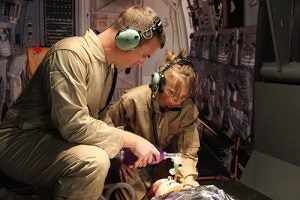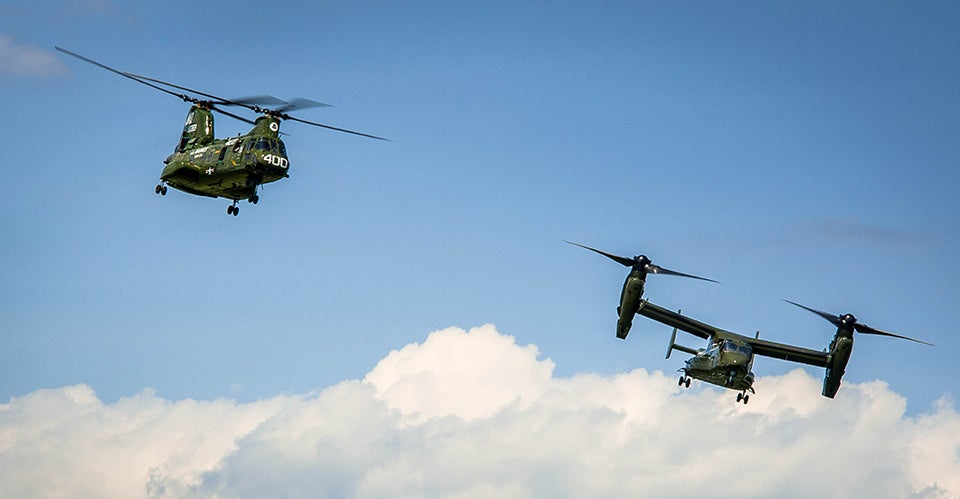ON BOARD AN OSPREY
Students build MV-22 task trainer
From the outside, it’s a big black cylinder, but step inside, and you’re aboard an MV-22 Osprey, a tiltrotor aircraft used by the military for critical transport and medical evacuation missions.
When the “engines” fire, it’s easy to believe you’re about to take off from an air base, not standing in a university lab on Jarvis Street.
The MV-22 Task Trainer, housed in East Carolina University’s Innovation Design Lab, was built as part of a collaboration between the university, the military and the Brody School of Medicine and is intended to provide training scenarios for Navy corpsmen and critical nurses who would not otherwise have an opportunity to practice a medical evacuation under realistic conditions.
“It recreates the environment in which they’re going to have to work,” said Jim Menke, military research liaison and project manager for Operation Reentry N.C. “Our medical personnel can learn to do procedures and monitor patients, and do all those things in a clinical situation, with a bed in a hospital.

Jourdan (left) and Strickland demonstrate intubation of a high-fidelity mannequin from the Brody School of Medicine. (Photo by Wayne Godwin)
“But when (you’re aboard an aircraft), you lose a hand to communicate because you have to push to talk. It’s extremely noisy; you have to wear a headset to communicate and hear what’s going on. At night you’re under green light, so vision is difficult. You’re on your knees because the patient is on a stretcher on the floor of the aircraft. There’s vibration. There’s a very strong diesel smell; your eyes will burn.”
ECU students in a variety of disciplines had a hands-on role in designing and building the task trainer, which is capable of reproducing all of those conditions and more. The interior bay of an MV-22 was recreated inside a 4,800-gallon agricultural sprayer tank.
There’s engine noise, heat, wind, odors and vibration. An array of cameras captures each training exercise for debriefing. Even the “patients” are high-tech — they’re high-fidelity mannequins that have cardiac and blood pressure monitors — and the training missions are based on actual casualties from the military’s war trauma registry.
“The collaboration involving the Brody School of Medicine Clinical Simulation Program, the ECU Office of Innovation and Economic Development, and the military is an important one,” said Dr. Skip Robey, assistant dean of safety and simulation at Brody. “Integration of the Osprey simulator into the current corpsman simulation training activities adds an important dimension to the reality-based educational experience.”
“The project was pretty much student-led,” Menke added. “We had biomedical engineering students, ceramics, art and design, and education. Geography students went down and laser mapped the inside of an Osprey so we’d have measurements for how to recreate it. It has been a multidisciplinary, cross-campus project to get it built and working. Now we’re working with medical students to develop the training.”
Brendan Mims, a graduate student studying ceramics, helped turn the agricultural tank into a convincing replica of an aircraft interior.
“I was brought on for my background in construction and problem solving with alternative material,” he said. “It has helped my education by exposing me to material I had not utilized before, and increased my ability to create prototypes for ceramic mold making.”
Another tool available for training is an Oculus virtual reality headset, which provides a 3-dimensional representation of the aircraft for familiarization purposes. As a graduate student in biomedical engineering, Blair Weaver helped create the virtual environment.
She visited Marine Corps Air Station New River in Jacksonville and used 12 GoPro cameras to capture full spherical video of an MV-22 Osprey. Using the Oculus Rift headset, she said, “military personnel can train at our lab by immersing themselves in this setting and experiencing the Osprey as if they were actually in one.”
The MV-22, which is capable of both short and vertical takeoffs and landings, is replacing the CH-46 helicopter that the military formerly used for these kinds of missions. The Osprey flies faster and at a higher altitude, and it can be refueled in flight, extending its range and increasing the potential complexity of its missions.
“We’re allowing them to practice tasks like crew coordination; they have to coordinate just like the pilot and copilot would on an aircraft,” Menke said. “You have a critical care nurse and corpsmen, and they have to learn to work as a team to take care of that patient. This is a much more cost-effective means to practice these long exercises.”

The MV-22 Osprey (right) is a tiltrotor aircraft with vertical takeoff and landing capabilities. It is used for critical transport and medical evacuation missions, replacing the CH-46 helicopter. (Photo courtesy of U.S. Marine Corps)